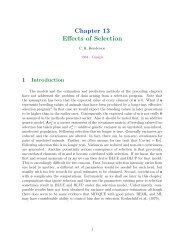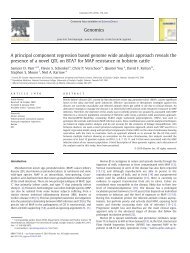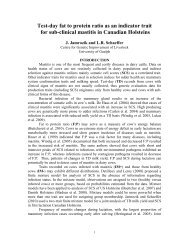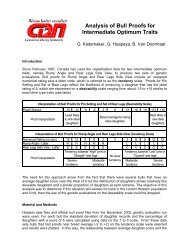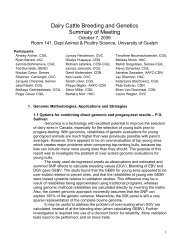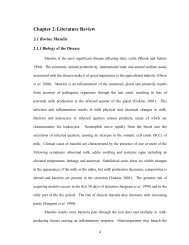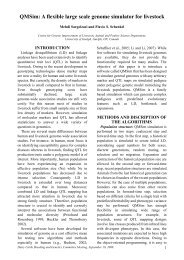mapping of qtls for prolificacy traits on ssc8 using a candidate gene ...
mapping of qtls for prolificacy traits on ssc8 using a candidate gene ...
mapping of qtls for prolificacy traits on ssc8 using a candidate gene ...
You also want an ePaper? Increase the reach of your titles
YUMPU automatically turns print PDFs into web optimized ePapers that Google loves.
7th World C<strong>on</strong>gress <strong>on</strong> Genetics Applied to Livestock Producti<strong>on</strong>, August 19-23, 2002, M<strong>on</strong>tpellier, France<br />
MAPPING OF QTLS FOR PROLIFICACY TRAITS ON SSC8 USING A CANDIDATE<br />
GENE APPROACH<br />
Z. Jiang 1 , J.A.B. Robins<strong>on</strong> 1 , A.M. Verrinder Gibbins 1 , J.P. Gibs<strong>on</strong> 1 , A.L. Archibald 2 and<br />
C.S. Haley 2<br />
1 CGIL, Department <str<strong>on</strong>g>of</str<strong>on</strong>g> Animal and Poultry Science, University <str<strong>on</strong>g>of</str<strong>on</strong>g> Guelph, Guelph, Canada<br />
N1G 2W1<br />
2 Roslin Institute (Edinburgh), Roslin, Midlothian, UK EH25 9PS<br />
INTRODUCTION<br />
Sow <str<strong>on</strong>g>prolificacy</str<strong>on</strong>g> is a critical factor affecting the pr<str<strong>on</strong>g>of</str<strong>on</strong>g>itability <str<strong>on</strong>g>of</str<strong>on</strong>g> the swine industry. While there<br />
have been large increases in productivity attributable to improvement in <strong>gene</strong>tics and<br />
management, litter size has remained unchanged <str<strong>on</strong>g>for</str<strong>on</strong>g> several decades. Genetic improvement has<br />
been difficult to achieve <strong>using</strong> traditi<strong>on</strong>al selecti<strong>on</strong> methods due to the low heritabilities <str<strong>on</strong>g>of</str<strong>on</strong>g><br />
<str<strong>on</strong>g>traits</str<strong>on</strong>g> involved (Roehe and Kennedy, 1995). Meishan pigs are perhaps <strong>on</strong>e <str<strong>on</strong>g>of</str<strong>on</strong>g> the most prolific<br />
breeds <str<strong>on</strong>g>of</str<strong>on</strong>g> pig in the world. They reach puberty at 2.5 - 3 m<strong>on</strong>ths <str<strong>on</strong>g>of</str<strong>on</strong>g> age, achieve high embryo<br />
survival rates, and a large litter size <str<strong>on</strong>g>of</str<strong>on</strong>g> 15 - 16 pigs. Although a few Meishan-synthetic gilts<br />
appeared <strong>on</strong> the market in the early 1990s, the promise <str<strong>on</strong>g>of</str<strong>on</strong>g> a commercial boost to litter<br />
productivity has not yet been realized. The reas<strong>on</strong> is that the large advantages in litter size are<br />
finely balanced with equally large disadvantages in growth and carcass value. There<str<strong>on</strong>g>for</str<strong>on</strong>g>e, the<br />
identificati<strong>on</strong> and introducti<strong>on</strong> <str<strong>on</strong>g>of</str<strong>on</strong>g> <strong>on</strong>ly alleles <str<strong>on</strong>g>for</str<strong>on</strong>g> the high <str<strong>on</strong>g>prolificacy</str<strong>on</strong>g> <str<strong>on</strong>g>of</str<strong>on</strong>g> Taihu pigs into highly<br />
productive European/American breeds would have obvious commercial value.<br />
Using a whole genome scanning approach with microsatellite markers, it was determined that<br />
there are three quantitative trait loci influencing ovulati<strong>on</strong> rate <strong>on</strong> porcine chromosome 8<br />
(Rathje et al., 1997 ; Rohrer et al., 1999 and Wilkie et al., 1999). These indicate the importance<br />
<str<strong>on</strong>g>of</str<strong>on</strong>g> screening porcine chromosome 8 <str<strong>on</strong>g>for</str<strong>on</strong>g> additi<strong>on</strong>al markers, especially <strong>candidate</strong> <strong>gene</strong>s <str<strong>on</strong>g>for</str<strong>on</strong>g><br />
<str<strong>on</strong>g>prolificacy</str<strong>on</strong>g> in pigs. The <strong>gene</strong> encoding the g<strong>on</strong>adotropin-releasing horm<strong>on</strong>e receptor (GNRHR)<br />
has been mapped to chromosome 8. Jiang and colleagues (2001) obtained an almost complete<br />
sequence (3993 bp, excluding intr<strong>on</strong> 1) <str<strong>on</strong>g>of</str<strong>on</strong>g> the porcine GNRHR <strong>gene</strong> <strong>using</strong> PCR-based<br />
comparative genomic walking and inverse genomic walking approaches. Twelve <strong>gene</strong>tic<br />
polymorphisms were detected by sequencing <str<strong>on</strong>g>of</str<strong>on</strong>g> pooled DNA <str<strong>on</strong>g>of</str<strong>on</strong>g> Chinese Taihu and Large<br />
White pigs. An F2 populati<strong>on</strong> <str<strong>on</strong>g>of</str<strong>on</strong>g> Meishan x Large White pigs was genotyped <str<strong>on</strong>g>for</str<strong>on</strong>g> a TG<br />
deleti<strong>on</strong>/inserti<strong>on</strong> in the promotor regi<strong>on</strong>, and a C/G substituti<strong>on</strong> in the 3’UTR. A significant<br />
associati<strong>on</strong> <str<strong>on</strong>g>of</str<strong>on</strong>g> the C/G substituti<strong>on</strong> with number <str<strong>on</strong>g>of</str<strong>on</strong>g> corpora lutea at first parity was observed.<br />
Measuring c<strong>on</strong>servati<strong>on</strong> <str<strong>on</strong>g>of</str<strong>on</strong>g> c<strong>on</strong>tiguous sets <str<strong>on</strong>g>of</str<strong>on</strong>g> autosomal markers between human and porcine<br />
genomes has revealed that SSC8 is homologous to a regi<strong>on</strong> from approximately 0 - 170 Mb <strong>on</strong><br />
human chromosome 4 (HSA4) (Jiang et al., 2002 submitted). Based <strong>on</strong> human genome<br />
<str<strong>on</strong>g>mapping</str<strong>on</strong>g> in<str<strong>on</strong>g>for</str<strong>on</strong>g>mati<strong>on</strong>, several additi<strong>on</strong>al functi<strong>on</strong>al <strong>gene</strong>s in this regi<strong>on</strong> (AREG, FGG and STE)<br />
were found to be involved in reproducti<strong>on</strong>. Amphiregulin (AREG), a member <str<strong>on</strong>g>of</str<strong>on</strong>g> the epidermal<br />
growth factor (EGF) family, is <strong>on</strong>e <str<strong>on</strong>g>of</str<strong>on</strong>g> the <strong>gene</strong>s important <str<strong>on</strong>g>for</str<strong>on</strong>g> appropriate embry<strong>on</strong>ic<br />
attachment (Giudice, 1999). Granulosa cells from ovarian follicles were shown to express and<br />
Sessi<strong>on</strong> 08. Reproducti<strong>on</strong> Communicati<strong>on</strong> N° 08-02
7th World C<strong>on</strong>gress <strong>on</strong> Genetics Applied to Livestock Producti<strong>on</strong>, August 19-23, 2002, M<strong>on</strong>tpellier, France<br />
secrete fibrinogen gamma chain (FGG) under the c<strong>on</strong>trol <str<strong>on</strong>g>of</str<strong>on</strong>g> FSH (Parrott et al., 1993).<br />
Purint<strong>on</strong> and Wood (2000) reported that ovine fetal hypothalamus and brainstem c<strong>on</strong>tain<br />
estrogen sulfotransferase (STE) in brain regi<strong>on</strong>s important <str<strong>on</strong>g>for</str<strong>on</strong>g> hypothalamus-pituitary-adrenal<br />
axis c<strong>on</strong>trol. The targeted disrupti<strong>on</strong> <str<strong>on</strong>g>of</str<strong>on</strong>g> murine estrogen sulfotransferase caused structural and<br />
functi<strong>on</strong>al lesi<strong>on</strong>s in the male reproductive system (Qian et al., 2001). AREG, FGG and STE<br />
have been mapped to human chromosome 4q13 - q21, 4q28 and 4q13.1, respectively. Here we<br />
report the detecti<strong>on</strong> <str<strong>on</strong>g>of</str<strong>on</strong>g> nucleotide polymorphisms in porcine AREG, FGG and STE <strong>gene</strong>s, and<br />
associati<strong>on</strong>s <str<strong>on</strong>g>of</str<strong>on</strong>g> these polymorphisms with <str<strong>on</strong>g>prolificacy</str<strong>on</strong>g> in an F2 populati<strong>on</strong> <str<strong>on</strong>g>of</str<strong>on</strong>g> Meishan x Large<br />
White pigs.<br />
MATERIALS AND METHODS<br />
Primer design and <strong>gene</strong>tic polymorphisms. Primer sequences <str<strong>on</strong>g>for</str<strong>on</strong>g> amplifying the PCR<br />
products in porcine AREG, FGG and STE <strong>gene</strong>s are as follows : AREG, F-<br />
CCAAAAGAAAGAAAAAGGGAGGCA and R-GCGGCTTTTCCCCACATCGTTCACC ;<br />
FGG, F-GTTTGTAGCATGTTAAAAATTTCGC and R-ATTTCCAGACCCATCAATTTCA;<br />
and STE, F-CCCAGCCTCAGCAATAGTATTAATA and R-ACTTATGTCTTCGTATCTAG<br />
CCGC. Genomic DNA (~50 ng) was amplified in a final volume <str<strong>on</strong>g>of</str<strong>on</strong>g> 10 µl c<strong>on</strong>taining 3 pmol <str<strong>on</strong>g>of</str<strong>on</strong>g><br />
each primer, 200 nM dNTPs, 2.5 mM MgCl2, 50 mM KCI, 10 mM Tris HCI, 0.1 % Trit<strong>on</strong><br />
X-100 and 0.5 U <str<strong>on</strong>g>of</str<strong>on</strong>g> Taq polymerase. After denaturati<strong>on</strong> at 94 o C <str<strong>on</strong>g>for</str<strong>on</strong>g> 3 min, 30 amplificati<strong>on</strong><br />
cycles were per<str<strong>on</strong>g>for</str<strong>on</strong>g>med comprising denaturati<strong>on</strong> at 94 o C <str<strong>on</strong>g>for</str<strong>on</strong>g> 30 sec, annealing at 57 o C <str<strong>on</strong>g>for</str<strong>on</strong>g> 30<br />
sec and extensi<strong>on</strong> at 72 o C <str<strong>on</strong>g>for</str<strong>on</strong>g> 30 sec, followed by a further 5-min extensi<strong>on</strong> at 72 o C. Direct<br />
sequencing <str<strong>on</strong>g>of</str<strong>on</strong>g> PCR products from 2 pooled DNA samples <str<strong>on</strong>g>of</str<strong>on</strong>g> 16 Chinese Erhualian and 16<br />
European Large White pigs was per<str<strong>on</strong>g>for</str<strong>on</strong>g>med <strong>using</strong> an ABI 377 automatic sequencer (Applied<br />
Biosystems, Foster City, USA) and standard protocols.<br />
Genotyping. PCR-RFLP, Bi-PASA and PCR-DSCP techniques were used to genotype<br />
markers in the porcine AREG, FGG and STE <strong>gene</strong>s, respectively. In the PCR-RFLP assays, 5<br />
µl PCR products were digested with 5 U StyI <str<strong>on</strong>g>for</str<strong>on</strong>g> the G/A substituti<strong>on</strong> at the porcine AREG<br />
<strong>gene</strong>. Inner primers <str<strong>on</strong>g>for</str<strong>on</strong>g> the Bi-PASA genotyping <str<strong>on</strong>g>of</str<strong>on</strong>g> a TCT indel in FGG were: GGGCGGGGG<br />
CAATCTGAAAAAGAAGAA and GGGCGGGGGCGTAAAATCATCTTCTTT. Both PCR-<br />
RFLP and Bi-PASA products were then examined by electrophoresis <strong>on</strong> 1.5 % agarose gel<br />
with 1X TBE buffer, while PCR products <str<strong>on</strong>g>of</str<strong>on</strong>g> the STE <strong>gene</strong> were examined <strong>using</strong> 8 %<br />
acrylamide gels. The gels were stained with ethidium bromide and photographed.<br />
Marker-trait associati<strong>on</strong> analysis. Estimates <str<strong>on</strong>g>of</str<strong>on</strong>g> the effect <str<strong>on</strong>g>of</str<strong>on</strong>g> polymorphisms <strong>on</strong> sow<br />
reproducti<strong>on</strong> <str<strong>on</strong>g>traits</str<strong>on</strong>g> were obtained by fitting a linear model including genotypes at the three loci<br />
described above, and year as fixed effects and, <str<strong>on</strong>g>for</str<strong>on</strong>g> all <str<strong>on</strong>g>traits</str<strong>on</strong>g> except age at first mating, linear<br />
covariates <str<strong>on</strong>g>for</str<strong>on</strong>g> age at first mating, weight at laparoscopy or age at farrowing, <strong>using</strong> the GLM<br />
procedure <str<strong>on</strong>g>of</str<strong>on</strong>g> SAS. Traits analyzed were entire teats (ET), age at first mating (AFM), number <str<strong>on</strong>g>of</str<strong>on</strong>g><br />
mating (NOM), number <str<strong>on</strong>g>of</str<strong>on</strong>g> corpora lutea observed by laparoscopy (NCL), gestati<strong>on</strong> length<br />
(GL), number born (NB) and number born alive (NBA). All <str<strong>on</strong>g>traits</str<strong>on</strong>g> except AFM were recorded<br />
at 1 st and 2 nd parity, with records at the two parities being c<strong>on</strong>sidered as separate <str<strong>on</strong>g>traits</str<strong>on</strong>g>, denoted<br />
NCL1, NCL2, GL1, GL2, etc.<br />
Sessi<strong>on</strong> 08. Reproducti<strong>on</strong> Communicati<strong>on</strong> N° 08-02
7th World C<strong>on</strong>gress <strong>on</strong> Genetics Applied to Livestock Producti<strong>on</strong>, August 19-23, 2002, M<strong>on</strong>tpellier, France<br />
RESULTS AND DISCUSSION<br />
DNA direct sequencing <str<strong>on</strong>g>of</str<strong>on</strong>g> two pooled samples from Meishan and Large White pigs revealed a<br />
C/T substituti<strong>on</strong> in AREG, a TCT indel in FGG and a C/A substituti<strong>on</strong> in the STE <strong>gene</strong>. The<br />
C/T substituti<strong>on</strong> in the AREG <strong>gene</strong> can be detected with the restricti<strong>on</strong> enzyme StyI (figure<br />
1A). The PCR products <str<strong>on</strong>g>of</str<strong>on</strong>g> the AREG <strong>gene</strong> have also a comm<strong>on</strong> cut site <str<strong>on</strong>g>for</str<strong>on</strong>g> StyI <str<strong>on</strong>g>for</str<strong>on</strong>g> all animals,<br />
which serves as an internal c<strong>on</strong>trol. In FGG genotyping, all animals show a comm<strong>on</strong> band<br />
amplified with the outer primers, while allele specific bands were <strong>gene</strong>rated with allele specific<br />
primers (figure 1B). PCR-DSCP analysis revealed three genotypes in the STE <strong>gene</strong> : lane 1,<br />
heterozygous ; lane 2, homozygous <str<strong>on</strong>g>for</str<strong>on</strong>g> allele1 and lanes 3 - 6, homozygous <str<strong>on</strong>g>for</str<strong>on</strong>g> allele 2 (figure<br />
1C). All polymorphic markers were shown to be under simple <strong>gene</strong>tic c<strong>on</strong>trol by segregati<strong>on</strong><br />
analysis in multiple three-<strong>gene</strong>rati<strong>on</strong> families <str<strong>on</strong>g>of</str<strong>on</strong>g> Meishan -Large White crosses.<br />
Data analysis revealed that an allele dominant in Meishan pigs at the FGG <strong>gene</strong> (allele A1) was<br />
associated with a desirable effect <strong>on</strong> number born and number born alive in the sec<strong>on</strong>d parity.<br />
All estimates summarized in table 1 are relative to the homozygote A2A2 which was set to<br />
zero <str<strong>on</strong>g>for</str<strong>on</strong>g> estimability. The homozygote (A1A1) and heterozygote (A1A2) genotypes were<br />
associated with 2.71 and 3.27 piglets (P = 0.0469) more in number born and 2.29 and 3.20 (P =<br />
0.0266) more in number born alive than the homozygotes with the undesirable allele (A2).<br />
However, a Meishan allele (A1) at the AREG <strong>gene</strong> was associated with an undesirable effect <strong>on</strong><br />
number born in the first parity : 1.65 (A1A1) and 2.06 (A1A2) piglets fewer born than <str<strong>on</strong>g>for</str<strong>on</strong>g><br />
A2A2 homozygotes (table 1). The STE <strong>gene</strong> showed overdominance effects <strong>on</strong> both GL1 and<br />
ET (P < 0.0002 and P < 0.0603).<br />
All <str<strong>on</strong>g>of</str<strong>on</strong>g> the nucleotide polymorphisms analyzed in the porcine AREG, FGG and STE <strong>gene</strong>s were<br />
located in intr<strong>on</strong>s. Although the SNPs in intr<strong>on</strong>s do not directly alter any functi<strong>on</strong>ally important<br />
amino acid residue, they may prove useful as markers <str<strong>on</strong>g>for</str<strong>on</strong>g> functi<strong>on</strong>al cSNP via linkage<br />
disequilibrium <str<strong>on</strong>g>mapping</str<strong>on</strong>g>. In additi<strong>on</strong>, some intr<strong>on</strong>s play a role in regulating <strong>gene</strong> expressi<strong>on</strong> and<br />
thus their c<strong>on</strong>stituent SNPs may be directly related to functi<strong>on</strong>al variati<strong>on</strong>. More <strong>gene</strong>rally, the<br />
present study provides evidence to support the existence <str<strong>on</strong>g>of</str<strong>on</strong>g> QTLs <str<strong>on</strong>g>for</str<strong>on</strong>g> <str<strong>on</strong>g>prolificacy</str<strong>on</strong>g> <str<strong>on</strong>g>traits</str<strong>on</strong>g> <strong>on</strong><br />
porcine chromosome 8. All <str<strong>on</strong>g>of</str<strong>on</strong>g> the results indicate the importance <str<strong>on</strong>g>of</str<strong>on</strong>g> porcine chromosome 8 <str<strong>on</strong>g>for</str<strong>on</strong>g><br />
additi<strong>on</strong>al <str<strong>on</strong>g>mapping</str<strong>on</strong>g>.<br />
Table 1. Significant associati<strong>on</strong>s between <strong>candidate</strong> <strong>gene</strong>s and reproductive <str<strong>on</strong>g>traits</str<strong>on</strong>g> in the<br />
Roslin Meishan x Large White populati<strong>on</strong><br />
Gene Trait A1A1 A1A2 LS Means Type III SS Pr > F<br />
AREG NB1 -1.65 * -2.06 ** 12.95 0.0534<br />
NOM1 -0.20 * -0.18 * 1.34<br />
0.0298<br />
FGG NB2 2.71 ** 3.27 ** 11.13<br />
0.0469<br />
NBA2 2.29 * 3.20 *** 10.43<br />
0.0266<br />
STE<br />
GL1<br />
ET<br />
0.28 (ns)<br />
-0.06 (ns)<br />
2.96 ***<br />
0.46 **<br />
118.1<br />
14.77<br />
0.0002<br />
0.0603<br />
Sessi<strong>on</strong> 08. Reproducti<strong>on</strong> Communicati<strong>on</strong> N° 08-02
7th World C<strong>on</strong>gress <strong>on</strong> Genetics Applied to Livestock Producti<strong>on</strong>, August 19-23, 2002, M<strong>on</strong>tpellier, France<br />
A B C<br />
Figure 1. Genotyping <str<strong>on</strong>g>of</str<strong>on</strong>g> nucleotide polymorphisms in the porcine AREG, FGG and STE<br />
<strong>gene</strong>s <strong>using</strong> PCR-RFLP (A), Bi-PASA (B) and PCR-DSCP (C) techniques (see text <str<strong>on</strong>g>for</str<strong>on</strong>g><br />
details)<br />
ACKNOWLEDGEMENTS<br />
We thank J.S. Melville and H.L. Baltzer <str<strong>on</strong>g>for</str<strong>on</strong>g> laboratory assistance. Financial assistance was<br />
provided by Genex Swine Group, Canada, Ontario Pork, Ontario Swine Improvement, the<br />
Natural Sciences and Engineering Research Council, Canada, the Ministry <str<strong>on</strong>g>of</str<strong>on</strong>g> Agriculture<br />
Fisheries and Food, UK, and Biotechnology and Biological Sciences Research Council, UK.<br />
REFERENCES<br />
Giudice, L.C. (1999) J. Reprod. Med. 44 : 165-171.<br />
Jiang, Z.H., Gibs<strong>on</strong>, J.P., Archibald, A.L. and Haley, C.S. (2001) Genome 44 : 7-12.<br />
Parrott, J.A., Whaley, P.D. and Skinner, M.K. (1993) Endocrinology 133 : 1645-1649.<br />
Purint<strong>on</strong>, S.C. and Wood, C.E. (2000) Neuroendocrinology 71 : 237-242.<br />
Qian, Y.M., Sun, X.J., T<strong>on</strong>g, M.H., Li. X.P., Richa. J. and S<strong>on</strong>g, W.C. (2001) Endocrinology<br />
142 : 5342-5350.<br />
Rathje, T.A., Rohrer, G.A. and Johns<strong>on</strong>, R.K. (1997) J. Anim. Sci. 75 : 1486-1494.<br />
Roehe, R and Kennedy, B.W. (1995) J. Anim. Sci. 73 : 2959-2970.<br />
Rohrer, G.A., Ford, J.J., Wise, T.H., Vallet, J.L. and Christens<strong>on</strong>, R.K. (1999) J. Anim. Sci. 77<br />
: 1385-1391.<br />
Wilkie, P.J., Paszek, A.A., Beattie, C.W., Alexander, L.J., Wheeler, M.B. and Schook, L.B.<br />
(1999) Mamm. Genome. 10 : 573-578.<br />
Sessi<strong>on</strong> 08. Reproducti<strong>on</strong> Communicati<strong>on</strong> N° 08-02





